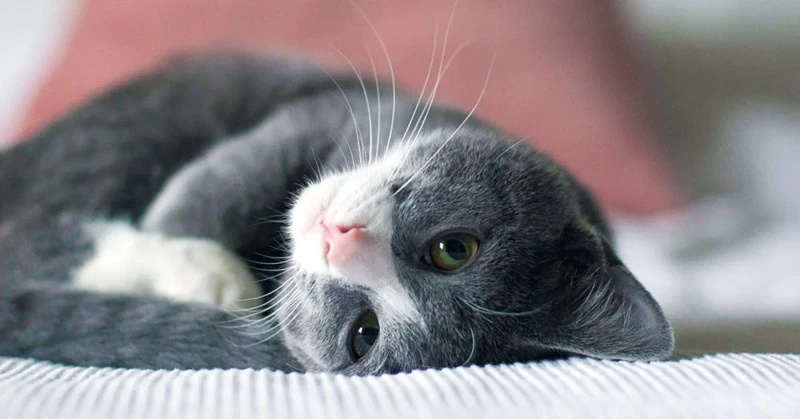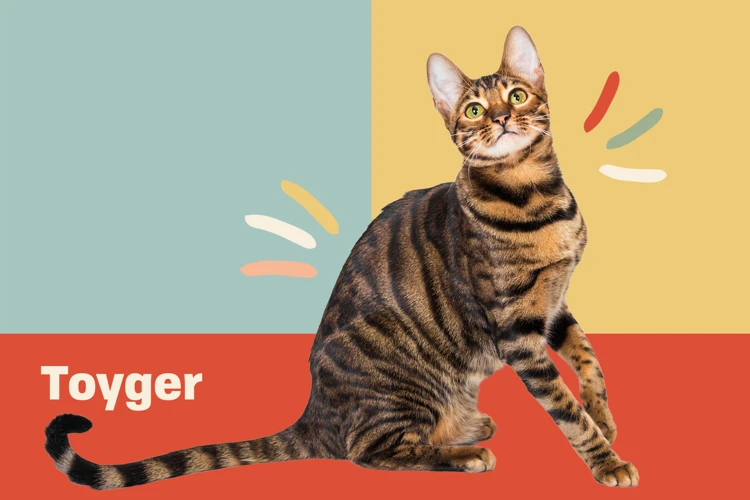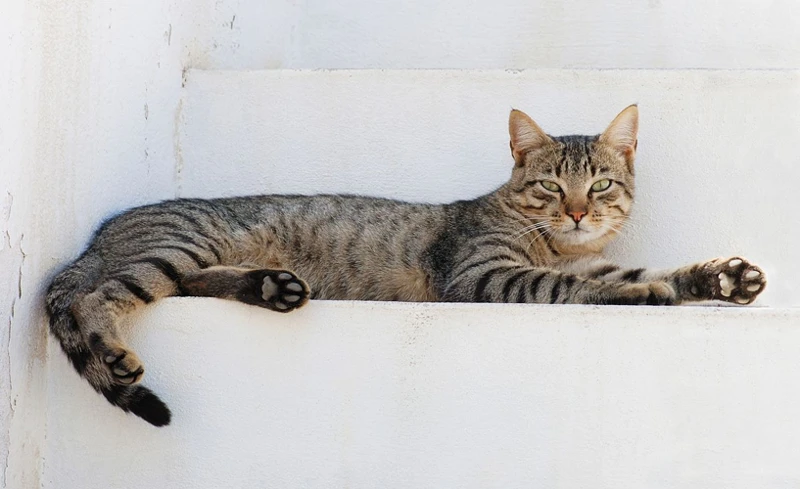As cat owners, we all want our feline friends to feel safe, loved, and relaxed at all times. However, just like humans, cats can experience fear and anxiety, which can affect their behavior and overall health. If you’re a California Spangled cat owner, you may be wondering how to help your furry companion overcome these issues. Luckily, clicker training may be the solution you’re looking for. This positive reinforcement method can not only teach your cat new commands but also build their confidence and reduce their anxiety. Let’s dive into the world of clicker training for California Spangled cats and learn how you can help your pet feel more comfortable in their environment.
Understanding Your California Spangled Cat

Understanding your California Spangled Cat is essential to successfully train them and help them overcome fear and anxiety with clicker training. These cats are known for their intelligence, high energy levels, and natural hunting abilities. They are also sensitive creatures that can easily become anxious or fearful in certain situations. By learning how to recognize these emotions and identify triggers, we can better understand how to approach clicker training with our California Spangled Cats. To learn more about the benefits of clicker training for California Spangled Cats, visit /calif-spangled-cat-clicker-training-benefits/.
Recognizing Fear and Anxiety
It’s important to recognize when your California Spangled cat is feeling fearful or anxious. Cats are very intuitive animals and can pick up on stress in their environments. Fear and anxiety can be caused by a variety of factors, such as loud noises, new people or animals in their territory, or changes to their daily routine.
Here are some signs that your California Spangled cat may be experiencing fear or anxiety:
- Hiding or running away from people or other animals
- Excessive meowing or hissing
- Peeing or pooping outside of their litter box
- Destructive behavior such as scratching furniture or carpet
- Refusal to eat or drink
- Excessive grooming, which can lead to hair loss
If you notice any of these signs, it’s important to address the issue right away to prevent it from escalating. Clicker training can be an effective way to help your California Spangled cat overcome their fears and anxieties. For more information on clicker training, check out our cat clicker training guide.
Identifying Triggers
Identifying Triggers: Before you can train your California Spangled Cat to overcome their fear and anxiety, it’s important to know what triggers their negative emotions. Some common triggers for cats include loud noises, new people, other animals, and changes in their environment. It’s also possible that your cat may have specific phobias, such as being afraid of a certain type of furniture or object.
To identify your cat’s triggers, start by observing their behavior in different situations. Notice their body language, such as flattened ears or a puffed-up tail, as well as any vocalizations they make. Keep a journal or list of situations in which your cat appears fearful or anxious. This can help you see patterns and create a plan for addressing these triggers.
Once you’ve identified your cat’s triggers, you can start to desensitize them to these situations through clicker training and other positive reinforcement techniques. By gradually exposing your cat to their triggers in a controlled and positive way, you can help them overcome their fear and anxiety and become more confident and comfortable in their environment.
It’s important to note that while identifying triggers is an important step in reducing your cat’s fear and anxiety, it’s not always easy or straightforward. If you’re struggling to determine what’s causing your cat’s negative feelings, consider consulting with a veterinarian or animal behaviorist who can offer additional guidance and support. Additionally, be sure to avoid common mistakes in clicker training that can negatively impact your cat’s progress and always prioritize their safety and well-being.
Clicker Training: A Positive Reinforcement Method

One of the most effective methods for training your California Spangled Cat to overcome fear and anxiety is through clicker training, a positive reinforcement method that focuses on rewarding desired behaviours. This type of training involves using a small handheld device called a clicker to mark the exact moment your cat performs a desired action, followed by a treat, which reinforces the behaviour.
Why Use Clicker Training?
Clicker training has many benefits for cats, including reducing stress levels and building confidence. It is a gentle and humane method that creates a positive learning environment for your cat while also strengthening the bond between you and your pet.
One of the key advantages of clicker training is its ability to target specific behaviours. This means that you can tailor your training to address your cat’s specific anxiety triggers and gradually work towards reducing fearful behaviours. Clicker training also encourages your cat to take an active role in the learning process, which can increase their self-confidence and independence.
Getting Started with Clicker Training
Before you begin clicker training your California Spangled Cat, it’s important to familiarize yourself with the basics of the technique. This includes choosing the right clicker for your cat and setting up a comfortable training space.
Choosing the Right Clicker:
When choosing a clicker, it’s important to find one that is comfortable to hold and easy to use. There are many types of clickers available, including traditional box-clickers, button-clickers, and even app-based clickers. Try a few different options to see what works best for you and your cat.
Setting Up Your Training Space:
Find a quiet, comfortable space to work with your cat, free from distractions. Make sure your cat has access to water, food, and litter before starting your training session to prevent any unnecessary interruptions.
Preparing for Training Sessions:
Before starting your training session, make sure your cat is calm and relaxed. Spend a few minutes petting and playing with your cat to help them feel more at ease. Plan out your training session in advance to ensure you have enough time to work on specific behaviours.
Teaching Basic Commands:
The first step in clicker training your California Spangled Cat is to teach them basic commands such as target training and click and treat.
Target Training:
Target training involves teaching your cat to touch a specific object, such as your hand or a target stick, with their nose or paw. Start by holding out your hand or target stick and rewarding your cat with a click and treat when they touch it. Gradually increase the distance between you and the object, encouraging your cat to move towards it and touch it on their own.
Click and Treat:
To teach your cat the connection between the click from the clicker and the reward, start by clicking the device and immediately following up with a treat. Repeat this process until your cat begins to associate the sound of the clicker with receiving a reward.
Building Confidence with Observed Training:
Observed training is a great way to build your cat’s confidence and reduce fear and anxiety. This involves observing your cat from a distance and clicking and treating any positive behaviours, such as exploring their environment or playing with toys. Over time, your cat will begin to associate positive behaviours with rewards and feel more comfortable in their surroundings.
Addressing Fear and Anxiety with Clicker Training
Clicker training can also be used to address fear and anxiety in your California Spangled Cat. Desensitization and counter-conditioning are two effective techniques for reducing fearful behaviours and creating positive associations.
Desensitization and Counter Conditioning:
Desensitization involves gradually exposing your cat to a trigger, such as a loud noise, and rewarding them for remaining calm. Counter conditioning involves creating positive associations with a trigger, such as pairing the sound of a loud noise with a favourite treat or toy. Over time, your cat will begin to see the trigger as a positive experience and feel less anxious or fearful.
Training Tips and Tricks:
To ensure that your clicker training sessions are successful, there are a few tips and tricks to keep in mind.
Pacing Yourself:
Training sessions should be kept short and sweet to prevent your cat from becoming bored or overwhelmed. Aim for 5-10 minutes of training at a time, with frequent breaks in between.
Staying Consistent:
Consistency is key when it comes to clicker training. Use the same clicker and treats each time and stick to a regular training schedule to help your cat build positive habits and behaviours.
Providing Rewards and Praise:
Always reward your cat with a treat or praise after each successful training session. This reinforces positive behaviours and encourages your cat to continue learning.
Remembering to Have Fun!
Clicker training should be a fun and enjoyable experience for both you and your California Spangled Cat. Don’t get too caught up in achieving specific outcomes and remember to enjoy the process of learning and bonding with your pet.
Clicker training is an effective and humane method for reducing fear and anxiety in your California Spangled Cat. By using positive reinforcement techniques and building a trusting relationship with your pet, you can help them become more confident, comfortable, and happy in their home environment. For more information on clicker training, check out our article on Cali Spangled Clicker Training.
Getting Started with Clicker Training

Embarking on a new type of training can be intimidating, but with clicker training, it’s easy to get started. Clicker training is a positive reinforcement method that can help your California Spangled Cat overcome their fears and anxieties. Before beginning, it’s important to understand the basics of clicker training, including choosing the right clicker, setting up your training space, and preparing for training sessions. Avoiding common mistakes is also crucial for success, and you can read more about them in our article on Clicker Training Mistakes to Avoid with California Spangled Cats.
Choosing the Right Clicker
When it comes to clicker training your California Spangled Cat, one of the most important decisions to make is choosing the right clicker. A clicker is a small handheld device that makes a distinct clicking noise when pressed, signaling to your cat that they have done something correctly. This sound will soon become associated with positive reinforcement and reward. So, how do you choose the right clicker for your cat?
Consider the Noise Level: Clickers come in different noise levels, so it’s important to choose one that your cat is comfortable with. Some clickers make a loud and crisp sound, while others are softer and more muffled. If your cat is sensitive to loud noises, it’s best to choose a softer clicker.
Size and Comfort: Clickers come in different shapes and sizes, so it’s important to choose one that feels comfortable in your hand and is easy to press. Some clickers are designed for smaller hands, while others are larger and easier to grip. Make sure the clicker you choose is easy for you to use during training sessions.
Durability: You’ll want to choose a clicker that is durable and long-lasting, as you’ll be using it frequently during training sessions. Look for a clicker that is made from high-quality materials and can withstand wear and tear.
Compatibility: Some clickers are designed for specific types of training, such as agility training or obedience training. Make sure the clicker you choose is compatible with the training techniques you plan to use.
Selecting the right clicker is an important step in clicker training your California Spangled Cat. Consider the noise level, size and comfort, durability, and compatibility when making your decision. Once you have chosen the right clicker, you’ll be ready to start training your cat in a positive and effective way!
For more information about clicker training for California Spangled cats, check out our advanced clicker training techniques or read up on the science behind clicker training.
Setting Up Your Training Space
Before starting clicker training, it’s important to set up a proper training space for your California Spangled Cat. Here are some tips on how to do it:
- Cleanliness: Choose a clean and clutter-free area for training. This will help your cat stay focused and minimize distractions.
- Noise level: Please keep the training area quite. Avoid loud music or TV noise, which can distract or frighten the cat.
- Lighting: Ensure that the training area is well-lit, so your cat can see you and the clicker clearly.
- Size of training space: Use a small space, preferably a room with doors or a playpen that can be easily enclosed. This will prevent your California Spangled Cat from wandering off during the training session.
Additionally, make sure you have all the necessary clicker training tools. This includes a clicking device, treats, and a training mat or blanket to help define the training area. By preparing a proper training space, you can help set your California Spangled Cat up for success and make the training process much smoother.
Preparing for Training Sessions
Successful training sessions depend on careful preparation. By taking the time to prepare ahead of time, you can ensure that your California Spangled Cat is receptive and ready to learn. Here are some steps you can take to prepare for training sessions:
- Choose a Quiet Space: Select a calm and quiet area where your cat can focus on the training. A space that is free from distractions will help your cat stay focused during the training session.
- Remove Any Hazards: It’s important to make sure your training space is safe for your cat. Check for any hazards or potential dangers, such as exposed electrical cords or sharp objects, and remove them before beginning the training session.
- Gather Your Supplies: Make sure you have all the necessary supplies on hand before starting the session. This could include treats, the clicker, and any training tools such as a target stick or a toy.
- Choose the Right Time: Pick a time of day when your cat is most alert and energetic. Avoid training during times when your cat is sleepy or distracted, as this will make it harder for them to focus on the training.
- Warm-Up Exercises: It’s always a good idea to start with some light warm-up exercises before beginning the actual training session. Warming up can help your cat get into the right mindset for learning and can help prevent injuries.
By following these steps, you can set your cat up for success and ensure that your training sessions are as effective as possible. Remember to always keep the training sessions fun and engaging for your cat, and to take breaks as needed to prevent frustration or burnout. Patience and consistency are key when it comes to clicker training, so don’t be discouraged if progress is slow at first. With dedication and persistence, you can help your California Spangled Cat overcome their fear and anxiety with clicker training.
Teaching Basic Commands

For many California Spangled cat owners, training their furry friend can be an exciting and fulfilling experience. By teaching your cat basic commands, not only can you improve communication between you and your pet, but you can also build a stronger bond. However, training a cat can be a tricky task, especially if your pet is experiencing fear and anxiety. Fortunately, with clicker training, you can use positive reinforcement to teach your cat, even if they’re feeling timid. In this section, we will explore the basics of clicker training and how it can help you teach your California Spangled cat some essential commands.
Target Training
Target training is a fundamental aspect of clicker training for cats and is the first step in teaching your California Spangled cat new behaviors. Target training involves teaching your cat to touch a specific target, such as a small stick or a finger, with their nose or paw. This creates a foundation for future training exercises and helps your cat understand what is expected of them.
Here are the key steps for target training your California Spangled cat:
- Step 1: Introduce the target to your cat and allow them to investigate it. You can place the target on the ground or hold it in your hand.
- Step 2: When your cat touches the target, immediately click the clicker and reward them with a treat. Repeat this several times to reinforce the behavior.
- Step 3: Once your cat is consistently touching the target, begin to add a verbal cue such as “touch”. Say the cue just before presenting the target.
- Step 4: Gradually increase the distance between the target and your cat, encouraging them to move towards the target to touch it.
- Step 5: Once your cat is reliably touching the target on cue, you can use this behavior to teach them other commands, such as jumping, climbing or weaving through obstacles.
It’s important to keep training sessions short and frequent to avoid overwhelming your cat. Aim for several 5-10 minute sessions throughout the day, rather than one long session.
Remember to:
- Be Patient: Target training may take some time, so be patient and consistent.
- Use Positive Reinforcement: Click and treat your California Spangled cat every time they touch the target. This will reinforce the desired behavior and encourage them to continue.
- Keep it Fun: Always maintain a positive and upbeat demeanor during training sessions and remember to have fun with your cat.
With consistent target training and positive reinforcement, your California Spangled cat can become confident and well-behaved, making it easier for them to overcome fears and anxieties.
Click and Treat
When it comes to clicker training, the “click and treat” method is a fundamental aspect of the approach. This method involves using a clicker to make a distinct sound followed by immediately rewarding your California Spangled cat with a treat or praise.
To properly execute this method, you will need to follow these steps:
| Step | Instructions |
|---|---|
| Step 1: | Introduce the clicker to your cat by clicking it and immediately giving them a treat. Repeat this process several times, so your cat begins to associate the sound of the clicker with a reward. |
| Step 2: | Choose a command such as “sit” or “come” and wait for your California Spangled cat to naturally perform that behavior. As soon as your cat performs the behavior, click the clicker and reward them with a treat. It is important to click the clicker at the exact moment they perform the desired behavior. |
| Step 3: | Repeat step two until your cat begins to associate the sound of the clicker with the desired behavior, and they perform that behavior on command. |
| Step 4: | Gradually introduce more complex behaviors, such as jumping or rolling over, and use the click and treat method to reinforce them. It is important to always click at the exact moment they perform the behavior and to immediately reward them. |
The click and treat method is an effective way to teach your California Spangled cat new behaviors while reinforcing positive behavior. The sound of the clicker will begin to act as a cue that tells your cat when they are doing something right and offering them a treat or praise will further encourage that behavior.
Building Confidence with Observed Training
To build confidence in your California Spangled Cat, observed training can be a helpful tool. This involves exposing your cat to a training session without actively participating at first. Here are some steps for incorporating observed training into your clicker training routine:
Step 1: Set up the Training Environment: Choose a quiet room where you can observe your cat without distracting them. Set up the training area with familiar objects and toys to make your cat feel at ease.
Step 2: Begin the Training Session: Start the clicker training session while your cat is in the room. Use a familiar command and reward system. This will help your cat become familiar with the routine and feel more comfortable with the process.
Step 3: Observe Your Cat: During the training session, observe your cat’s behavior. Note any signs of fear or anxiety, such as hiding or freezing. If your cat becomes fearful, stop the training session and try again later.
Step 4: Gradually Increase Your Participation: As your cat becomes more comfortable with the training routine, gradually increase your participation. You can start by simply standing near your cat during the session, and eventually move closer and participate more actively.
Step 5: Provide Rewards: Always provide your cat with rewards and praise during the training session. This will help build positive associations and reinforce good behavior.
By incorporating observed training into your clicker training routine, you can help build your California Spangled Cat’s confidence and reduce fear and anxiety. Remember to take your time and be patient throughout the process.
Addressing Fear and Anxiety

Calming down a fearful and anxious California Spangled Cat is an important part of training. It can be challenging to identify the sources of distress, but there are proven methods for addressing those fears. By using positive reinforcement techniques and creating a safe and enjoyable atmosphere, you can help your cat build confidence and overcome their anxiety. Here are some strategies to address fear and anxiety and make your cat feel comfortable in their environment.
Desensitization and Counter Conditioning
Desensitization and counter conditioning can be powerful tools in helping your California Spangled Cat overcome fear and anxiety. Desensitization involves gradually exposing your cat to the trigger that causes fear or anxiety in a controlled and safe manner. This helps them become accustomed to the trigger without feeling overwhelmed. Counter conditioning involves changing your cat’s emotional response to the trigger from fear or anxiety to a positive response.
Here are some steps you can take to use desensitization and counter conditioning:
- Start with a low-level exposure to the trigger. For example, if your cat is afraid of loud noises, begin by playing a recording of a low-level noise.
- While the trigger is present, offer your cat treats or play with them. This helps to distract them and create a positive association with the trigger.
- Gradually increase the exposure time and intensity as your cat becomes more comfortable with the trigger.
- If at any point your cat shows signs of fear or anxiety, back off and lower the level of exposure.
- Keep the training sessions short and consistent to avoid overwhelming your cat.
- Over time, your cat will learn that the trigger is not something to be feared and may even begin to look forward to the positive reward associated with it.
It’s important to remember that desensitization and counter conditioning take time and patience. It’s also crucial to take cues from your cat and understand when they are feeling overwhelmed. By using this technique, you can help your furry friend overcome their fear and anxiety and build a happier, healthier bond between you both.
Creating Positive Associations
Creating positive associations is a powerful technique that can help your California Spangled Cat overcome fear and anxiety. The goal is to replace negative associations with positive ones, so your feline friend feels more at ease in situations that once caused fear or anxiety. This can be achieved through a process called classical conditioning, where you pair a positive stimulus with a negative one to change your cat’s emotional response.
Steps to Create Positive Associations
Here are the steps to create positive associations in your California Spangled Cat:
| Step | Description |
|---|---|
| Identify the Trigger | First, identify the trigger that causes fear or anxiety in your cat. For example, if your cat is scared of loud noises, the trigger may be thunder or fireworks. |
| Pair with Positive Stimulus | Next, pair the trigger with a positive stimulus, like a favorite treat or toy. For example, every time there is thunder, give your cat their favorite treat. This will help them associate the thunder with the treat instead of fear. |
| Repetition | Repeat this process every time the trigger occurs, so your cat starts to associate it with something positive. This will create a new emotional response in your cat, changing their fear or anxiety to a positive feeling. |
It’s important to note that creating positive associations takes time and patience. You may not see immediate results, but with consistent training, your California Spangled Cat can learn to overcome their fears and anxieties.
Training Tips and Tricks
Now that you’ve established a solid foundation with clicker training and have a better understanding of your California Spangled Cat’s behavior, it’s time to explore some tips and tricks to keep your training sessions effective and enjoyable. While every cat is unique, some general guidelines can help you to overcome common training challenges. By implementing these strategies, you may find that your kitty is more motivated and responsive throughout the training process. So, let’s dive into some pro tips for clicker training your California Spangled Cat!
Pacing Yourself
As you begin your California Spangled Cat’s clicker training journey, it’s important to remember to pace yourself. While it can be exciting to jump right into training, it’s essential to take your time and work at a pace that’s comfortable for both you and your cat.
Why is pacing important in clicker training?
Clicker training is a gradual process that requires patience and consistency. Rushing through training sessions can result in your cat feeling overwhelmed or frustrated, which can hinder their progress. It’s essential to work at a pace that allows your cat to feel comfortable and confident in their abilities.
How to pace yourself in clicker training
To pace yourself during clicker training, you should begin by setting realistic goals for each training session. Remember to break down larger goals into smaller, achievable steps that your cat can accomplish.
You can use an html table to keep track of your training goals and progress. In the first column, write down your overall goal for your cat’s training, such as “Teaching my cat to stay calm during groomer visits.” In the second column, break down the goal into smaller steps, such as “Touch paw with brush,” “Touch paw with clippers,” “Turn on clippers at low volume,” and so on.
| Overall Goal | Steps to Achieve Goal |
|---|---|
| Teaching my cat to stay calm during groomer visits | Touch paw with brush, Touch paw with clippers, Turn on clippers at low volume, etc. |
During each session, work on achieving one or two of the smaller steps. Don’t move on to the next step until your cat has mastered the previous step. This allows your cat to build their confidence and prevents them from feeling overwhelmed.
Final thoughts
Remember, pacing yourself in clicker training is essential to your cat’s success. Break down larger goals into achievable steps, and work at a pace that allows your cat to feel comfortable and confident in their abilities. Using an html table to keep track of your goals and progress can help you stay organized and on track.
Staying Consistent
One of the most important aspects of clicker training your California Spangled cat to overcome fear and anxiety is staying consistent with your training methods. This means using the same clicker sound and treat rewards for each successful training response. Consistency helps your cat to understand what is expected of them and reinforces the positive behaviors that you want to see. Here are some tips for staying consistent:
- Stick to a Schedule: Establish a consistent training schedule, such as a regular time each day or week. This helps your cat to anticipate and prepare for training sessions.
- Use the Same Clicker Sound: Choose a specific sound for your clicker and use it consistently throughout all training sessions. Avoid using the clicker sound to get your cat’s attention outside of training sessions to prevent confusion.
- Provide Consistent Rewards: Use the same type of treat reward each time your cat demonstrates the desired behavior. This reinforces the behavior and helps to create a positive association with the clicker sound.
- Stick to Training Goals: Choose goals for each training session and stick to them. Don’t try to tackle too many behaviors at once, as this can lead to confusion and frustration for both you and your cat.
- Involve Family Members: If multiple family members are training your cat, make sure that everyone is using the same clicker sound and providing the same rewards. This helps to maintain consistency and reinforces positive behaviors.
Remember, consistency is key when it comes to clicker training your California Spangled cat. By sticking to a schedule, using the same clicker sound and treat rewards, and involving all family members in the training process, you can help your cat overcome fear and anxiety in a positive and rewarding way.
Providing Rewards and Praise
When training your California Spangled Cat with clicker training, it’s important to provide rewards and praise to reinforce positive behavior and keep your cat motivated. Here are some tips for providing rewards and praise:
- Use High-Value Treats: Make sure to use treats that your cat loves and don’t typically get as part of their regular diet. This will make the treat more enticing and your cat will be more motivated to repeat the behavior.
- Be Generous with Praise: Don’t be afraid to shower your cat with praise and affection whenever they do something right. Use a happy, energetic tone of voice and give plenty of physical affection like scratches or belly rubs.
- Timing is Key: Make sure to deliver the reward immediately after your cat performs the desired behavior. This will help your cat associate the behavior with the reward and encourage them to repeat it in the future.
- Vary the Rewards: While treats are a great reward, mix it up by using verbal praise, toys, or playtime as a reward as well. This will help keep training sessions interesting and prevent your cat from getting bored or disinterested.
- Don’t Overdo it: While it’s important to reward positive behavior, don’t overdo it with treats. Too many treats can lead to weight gain and other health issues. Use treats sparingly and supplement with other forms of rewards and praise.
Remember, providing rewards and praise is an important part of clicker training your California Spangled Cat. By keeping your rewards consistent, timed well, and varied, you’ll encourage positive behavior and help your cat overcome fear and anxiety.
Remembering to Have Fun!
Training your California spangled cat to overcome fear and anxiety with clicker training can be a challenging process. It’s important to remember to have fun and maintain a positive attitude throughout the training sessions.
Here are some tips for keeping the training fun and enjoyable for both you and your cat:
| Variety is Key | Reward Your Cat |
|---|---|
| Keep your training sessions interesting by changing up the routine. Switch between different commands and training exercises to keep your cat engaged and prevent boredom. | Remember to always reward your cat for their hard work. Using treats, praise, and playtime as rewards can make the training process more enjoyable and encourage your cat to continue learning. |
| Be Patient | Take Breaks |
| Training takes time, so be patient and don’t expect results overnight. Celebrate small successes and keep working towards your goals. | If you or your cat are feeling frustrated or overwhelmed, take a break and come back to training later. Taking breaks can help both you and your cat recharge and stay focused. |
Implementing these tips can help make clicker training a fun and rewarding experience for you and your California spangled cat. Always remember to stay positive, maintain a consistent training schedule, and most importantly, have fun!
Conclusion
In conclusion, training your California Spangled Cat to overcome fear and anxiety through clicker training is a rewarding process that requires patience, consistency, and positivity. By understanding your cat’s behaviors and triggers, you can identify areas of fear and anxiety that need to be addressed.
Clicker training is a powerful tool that uses positive reinforcement to build confidence and trust between you and your cat. By choosing the right clicker and creating a training space that is free from distractions, you can begin teaching basic commands such as target training and click and treat.
As you progress through the training sessions, it is important to address any fears and anxieties your cat may have. Desensitization and counter conditioning techniques can help create positive associations with previously fear-inducing stimuli. Always remember to provide rewards and praise for good behavior, and don’t forget to have fun!
Incorporating these training tips and tricks into your routine can help make the process smoother and more enjoyable for both you and your cat. Remember to pace yourself and stay consistent, as training takes time and effort.
Overall, clicker training offers a positive and effective way to train your California Spangled Cat to overcome fear and anxiety. With dedication and patience, you can build a strong bond with your feline companion and help them lead a happy, healthy, and confident life.
Frequently Asked Questions
1. Can clicker training work for all cats?
While clicker training can be effective for many cats, it may not work for all. Some cats do not respond well to positive reinforcement training methods and may require a different approach.
2. How long does it take for a cat to learn a new command?
This varies depending on the cat, the command being taught, and the skill level of the trainer. Some cats may learn a new command within a few repetitions, while others may require weeks of consistent training to fully learn a command.
3. Can clicker training help with aggression issues?
Clicker training can be a helpful tool in addressing aggression issues in cats. However, it is important to work with a professional trainer or behaviorist to ensure that the training is done safely and effectively.
4. Is it necessary to use a clicker during training?
No, a clicker is not necessary for positive reinforcement training. However, many trainers find that a clicker can be a helpful tool in marking the exact moment that a cat exhibits the desired behavior.
5. Is it possible to overtrain a cat?
Yes, it is possible to overtrain a cat. It is important to be mindful of a cat’s attention span and to avoid pushing them too hard during training sessions. Short, frequent sessions may be more effective than long, intense ones.
6. Can clicker training help with separation anxiety?
Clicker training can be a helpful tool in combating separation anxiety in cats. By creating positive associations with being alone and rewarding calm behavior, cats can learn to feel more comfortable when their owner is away.
7. Is it important to use treats during clicker training?
Treats can be a powerful motivator for cats during clicker training. However, it is not necessary to use treats in every training session. Verbal praise, playtime, and other rewards can be just as effective in reinforcing positive behavior.
8. Can clicker training be used to teach tricks?
Yes, clicker training can be a fun and effective way to teach cats tricks. By breaking down the trick into small, manageable steps and rewarding each step along the way, cats can learn impressive tricks such as jumping through hoops or walking on their hind legs.
9. Is it possible to use clicker training to stop a cat from scratching furniture?
Clicker training can be one tool in preventing your cat from scratching furniture. By providing appropriate scratching posts and rewarding your cat for using them, you can redirect their scratching behavior away from furniture.
10. Can clicker training help with litter box issues?
Clicker training can be helpful in addressing litter box issues such as inappropriate elimination. By creating positive associations with the litter box and rewarding your cat for using it, you can encourage them to use it consistently and prevent future issues.







